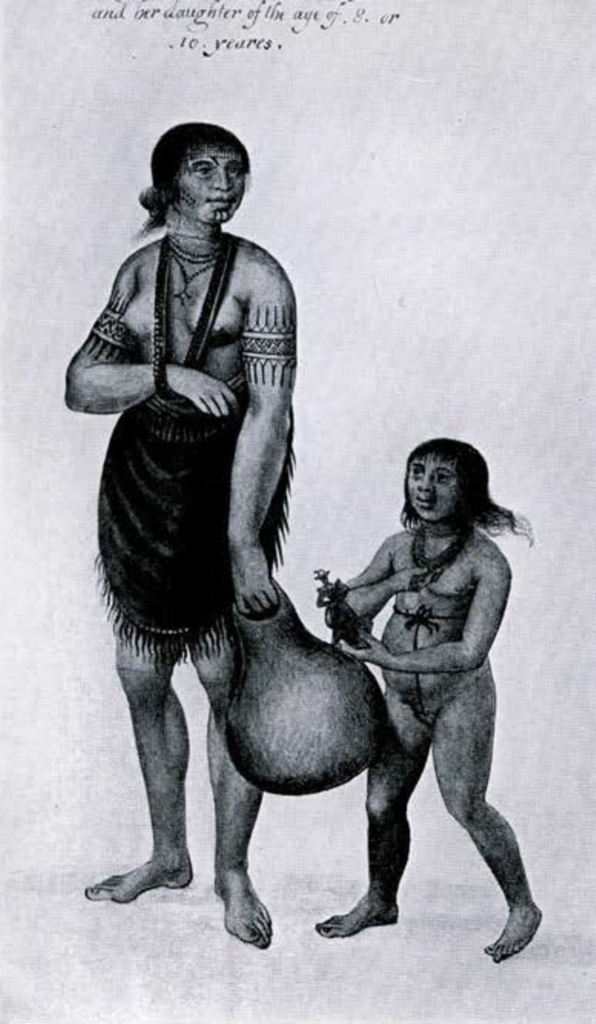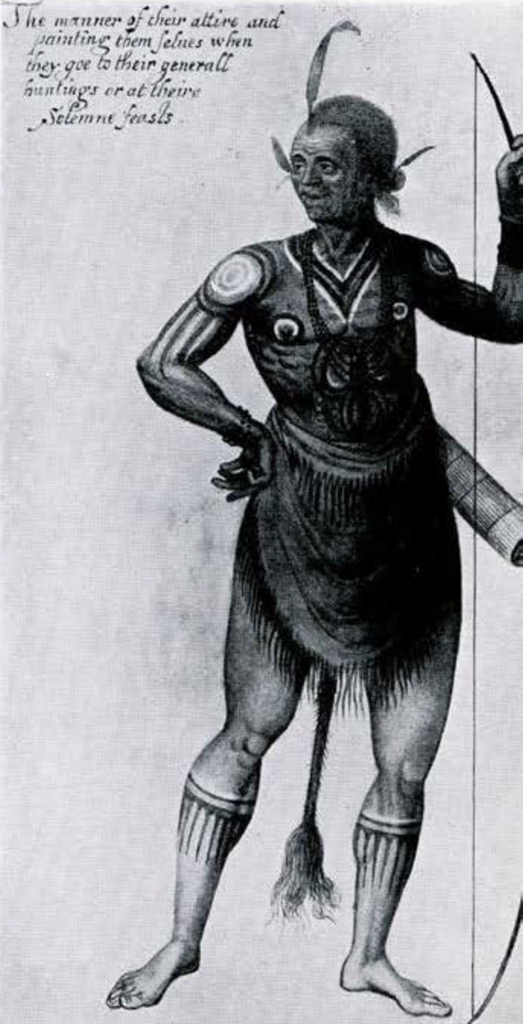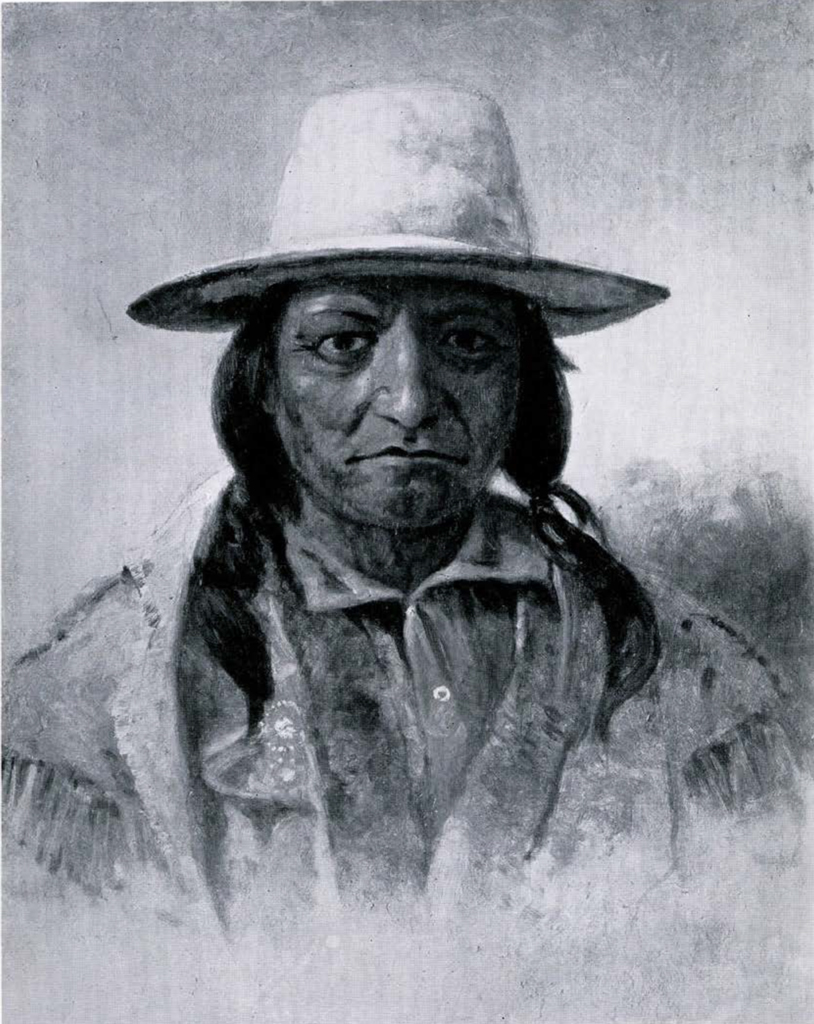So great was the appeal of European articles of apparel and adornment to the American Indian that they were adopted immediately after the first white contact. Since they often preceded, by means of trade, the advance of the settlers themselves, the first explorers often found the Indians wearing articles of civilized manufacture. Cloth and glass beads were especially desired by the natives. Seldom, therefore, was it the good fortune of a painter to be able to portray an Indian in strictly aboriginal garb. The most notable exception is the excellent-and ethnologically most important-group of sketches of natives of North Carolina made by John White in 1585. These show the Indians absolutely unaffected by European influence. The paucity of clothing is noteworthy, most of the natives, both men and women, being nude from the waist up and the knees down, and without foot gear. Body and face painting or tattooing takes the place of clothing. The hair was arranged in various coiffures, and ornaments of necklaces, bracelets and leg-ornaments were worn. The very long bows and wrist and finger-guards are shown.

Image Number: 13392, 22621
These sketches doubtless give an accurate impression of the Indians of the North Carolina coast at the close of the sixteenth century; they are not idealized as regards physical types. Most of the very latest paintings, made toward the close of the nineteenth century, generally of Indians of the Great Plains, are also true to life, strong, life-like, upstanding figures, with their great eagle-feather headdresses and beaded clothing. The ten little paintings done on copper by Shindler are especially noteworthy.
Less typical and naturalistic are some of the paintings of the three centuries between, though most of these are also excellent portrayals of noble figures. Poor Pocahontas in her ruff and fan of a lady of the court shows little of her pure Indian blood in her brown hair and eyes and light complexion.
Between the extremes of the semi-nude savages of North Carolina and the bedecked Pocahontas, paintings made at almost the same period and of almost the same people, we find the entire gamut of possibilities; stolid, pure Indian heads erupt above white lace collars or epauletted uniforms, or the softer faces of half-bloods bloom among typical native costumes. For, like the Negro, a modicum of native blood generally, in popular opinion, makes a person an Indian, especially if there are oil-rights concerned. For the greater part, however, the paintings show good aboriginal types in the costumes worn by their tribes at that time. The apparel is, to be sure, mainly of cloth purchased from traders and decorated with glass beads; rather few are shown with the buckskin shirts or bison-hide robes more characteristic of the primitive aborigine. But almost all show to a considerable degree the Indian love of adornment and finery, the bright-colored beaded cloths, the face-and-body-painting, the roaches, feathers and other head ornaments, the eagle-feather headdresses, necklaces, bracelets, and particularly the uniforms, medals and insignia awarded them by white officials. Even the noble British general wears his Iroquois moccasins and scarfs. Many of them carry their war clubs or pogamoggans of various ornate forms, and their long pipes or calumets. Notable exceptions are the plain stolid heavy faces of the Delaware chiefs Tishcohan and Lappawinze who saw their ancestral lands where we stand taken from them by smart bargaining.

Image Number: 13392
The relative unimportance of women in Indian relations with the whites is illustrated by the few paintings of them. (The words “Squaw,” “Pappoose,” and “Brave” are anathema to the modern ethnologist; the first two are Indian terms, but properly used by only one tribe.) In one respect that could not be falsified the paintings are all true to life; except for one or two half-bloods the men entirely lack beards, for the Indian has almost no body or face-hair, considered it unseemly, and plucked out the little that appeared.
Since a great many, if not the majority, of the paintings were made about 1830, Indians of the eastern tribes, groups that have now greatly diminished or almost disappeared, and who have almost all abandoned their native costumes, are especially well represented, particularly the Muskhogean Creek, Seminole and Choctaw; the Iroquoian Cherokee and the Yuchi also appear. In New York State the various tribes of the Iroquois, such as the Mohawk and Seneca, have several representatives. Especially well represented are the tribes of the east-central states, the Sauk and Fox, Menominee, and Chippewa or Ojibwa, as well as a few individuals of the Ottawa, Shawnee, Potawatomi, and Winnebago. These are all Indians of the woodland regions who depended little upon the horse or the bison and whose trappings were not so gay as those of the natives of the Great Plains. Though they dressed originally mainly in buckskin, at the time the paintings were made their apparel was mainly of cloth, decorated with beads, feathers and ribbons, though not cut in tailored coats and trousers; each tribe had its particular details of apparel.

Image Number: 12891
The more picturesque and colorful horse-and-buffalo Indians of the Great Plains and the Great Basin did not come into much contact with whites until after the beginning of the great transcontinental migrations in 1849. They, the several tribes of the Sioux or Dakota, the Pawnee, Iowa, Kansa, Oto, Assiniboin, Comanche, Shoshoni, Ute and Paiute, are therefore poorly represented in the earlier paintings, but some excellent types are shown in the later ones, mainly in the rear room, particularly ten small paintings on copper of the Sioux. These natives, when in gala attire, wore costumes of buckskin profusely decorated with beaded designs and great headdresses of eagle-feathers. The natives of the Southwest and the Pacific Coast are almost neglected, with only one small painting from each of the Navaho, Apache, Hupa and Modoc. The picturesque Pueblo Indians are entirely absent.
J. A. M.

